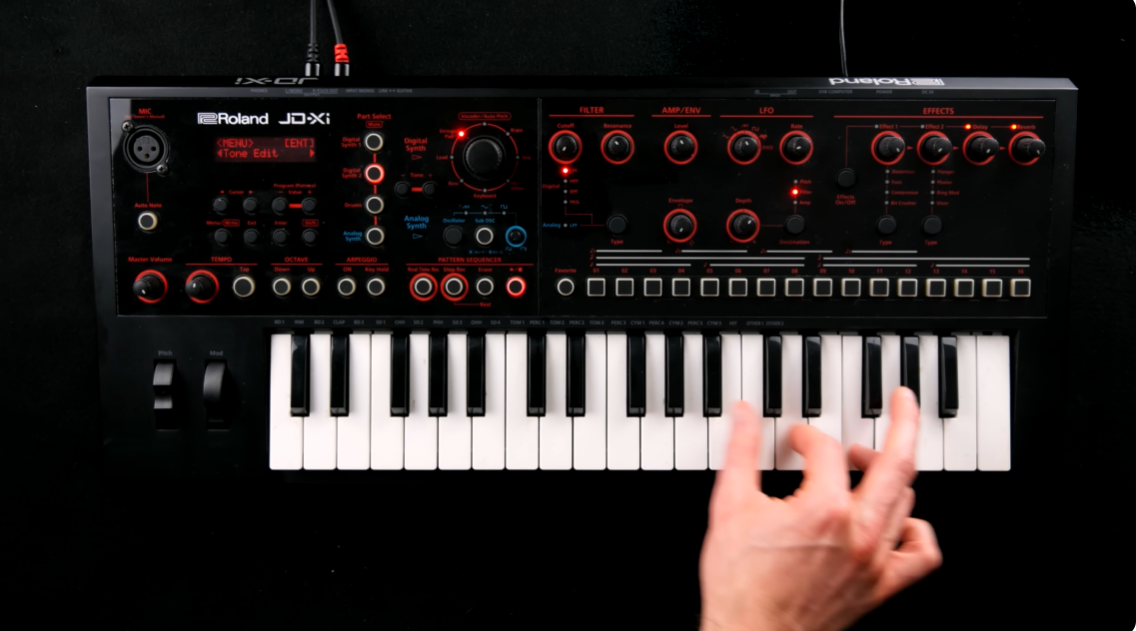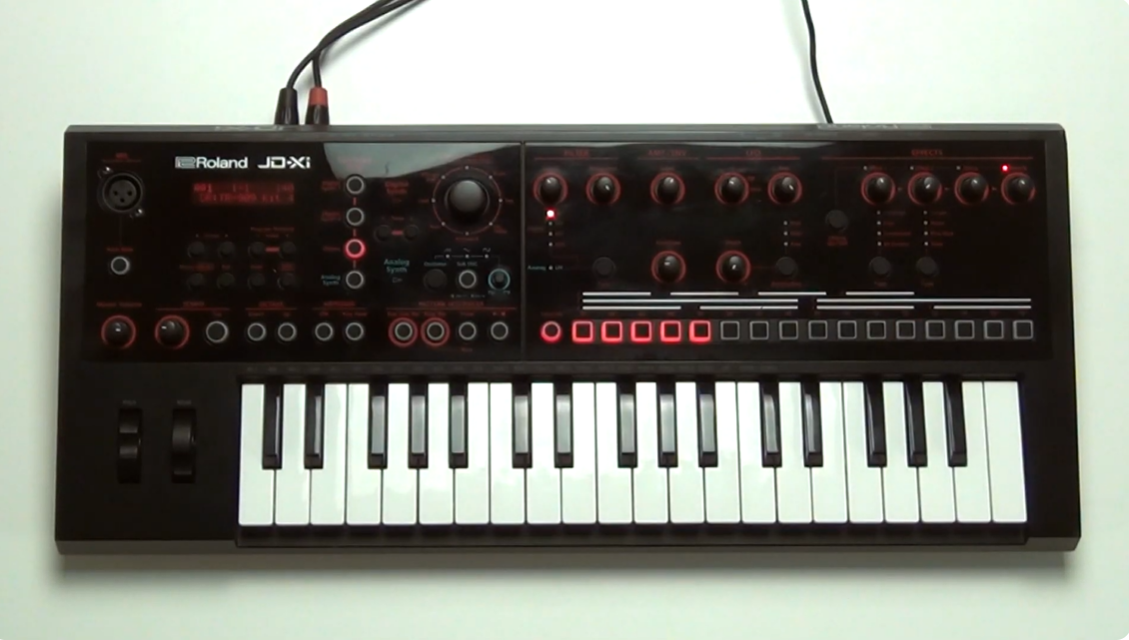If you’re a music producer, synth enthusiast, or live performer looking for a powerful synthesizer that packs both analog warmth and digital versatility into a compact frame, the Roland JD-XI might be exactly what you’re looking for. Often called “tiny but mighty,” this 37-key interactive synthesizer fuses traditional analog sound with cutting-edge digital features, sequencers, drum kits, and vocal effects. It’s no exaggeration to say that the JD-XI is more than just a synth—it’s a mini production studio in a box.
Let’s break down every detail of this intriguing instrument—from the build and design to its sonic capabilities—so you can decide if this is the synth that deserves a spot in your home studio or live rig.
Table of Contents
ToggleDesign and Build Quality – Compact but Surprisingly Rugged
At first glance, the Roland JD-XI looks sleek and modern. With its all-black finish, smooth curves, and brightly lit backlit buttons, it gives off a high-tech vibe. The plastic housing might not scream “premium,” but it’s solidly built. It doesn’t creak or flex under pressure, and every knob and button feels tactile and responsive. The design is clearly meant for portability, but that doesn’t mean Roland sacrificed reliability.
The red LED backlighting provides excellent visibility in dark studio environments or onstage. The layout is intuitive, even for beginners, and everything is within easy reach. You won’t be fumbling around trying to figure out where things are—the interface makes sense, and the labeling is clear. It’s smartly organized into sections: analog, digital, drums, effects, and sequencer, each with its own dedicated controls.
Physical Dimensions and Portability – Built to Move
The JD-XI’s small size is a blessing for anyone working with limited space or who travels often. Measuring 28 inches wide, 13 inches deep, and just 5 inches tall, it fits comfortably on any desktop or keyboard stand. Weighing in at just 4.14 pounds, it’s extremely portable—light enough to carry in one hand or throw in a backpack. If you’re a live performer or a mobile producer, this synth will be one of the easiest pieces of gear to transport.
Despite its lightness, it feels like a quality instrument. It can handle a little rough handling in a backpack or gig bag. This makes it ideal for producers on the move or performers playing smaller venues, open mics, or electronic sets.
Material and Durability – Stronger Than It Looks
Though the chassis is mostly plastic, the JD-XI is sturdier than it appears. Roland has a reputation for reliable gear, and this synth is no exception. The knobs are firm, the buttons don’t wobble, and the pitch and modulation wheels offer a satisfying amount of resistance. Even the included gooseneck microphone is rugged, with a solid base and flexible neck that stays in place.
Is it built like a tank? No. But it doesn’t need to be. It’s meant to be portable and accessible, and in that regard, Roland found the perfect balance between lightweight and durable.
Sound Engine – Hybrid Heaven
The JD-XI’s biggest claim to fame is its crossover sound engine, which combines a true analog monophonic synth with dual digital polyphonic synths powered by Roland’s SuperNATURAL engine. Add a powerful drum section and you’ve got a 4-part multi-timbral synth capable of covering everything from lush cinematic pads to gritty acid bass.
The analog engine gives you authentic warmth, grit, and expressive depth, while the digital sections open up a world of clean, expansive textures that are great for modern genres like EDM, pop, hip-hop, synthwave, and ambient music.
Analog Synthesis – Real, Fat, and Punchy
Unlike most compact synths that only mimic analog sounds, the JD-XI gives you a real analog synth under the hood. It’s monophonic, meaning it plays one note at a time—perfect for basses and leads. You get basic waveforms like saw, triangle, and square, and the ability to shape them using an analog filter with resonance and pulse-width modulation.
It also includes a sub-oscillator, which brings deep, rumbling bass to your patches. This isn’t just a gimmick; it’s a powerful analog engine that adds real character to your sound.
Digital Synthesis – Modern and Expansive
On the digital side, Roland provides two SuperNATURAL synth sections, each polyphonic and packed with modern sounds. You’ll find pads, strings, brass, bells, EPs, sound effects, and more. The SuperNATURAL engine excels at producing rich, clean tones that sit well in a mix and respond naturally to your playing dynamics.
You can stack digital and analog sounds for deep, layered patches that evolve over time. There’s also sound expansion via Roland’s Axial sound library, where you can download new tones and genre-specific packs for free.
User Interface – Beginner Friendly, Pro Capable
For all its power, the JD-XI keeps things simple. The interface is clean and intuitive, with dedicated controls for filter cutoff, resonance, attack, decay, and other key parameters. Each section—analog, digital, drum, and effects—has its own row of controls, so you can instantly dial in what you need.
The display is small but functional, providing enough feedback to navigate presets, patterns, and settings. It’s not a touchscreen or color display, but it gets the job done. Deep editing requires some menu diving, but for most users, the hands-on knobs will be more than enough.
Control Layout – Smart and Accessible
Roland made a wise choice by separating performance and programming controls. Pitch and modulation wheels are on the left, while the center panel is divided into logical zones. The sequencer section includes pattern start/stop, track selection, and TR-style step buttons. The filter and envelope sections are grouped with their respective synth parts.
This organization makes it easy to build songs, tweak tones, or perform live without getting lost. It’s an efficient interface that beginners will grasp quickly while still offering enough depth for pros.
Display and Navigation – Simple and Functional
The display is a backlit LCD, and while it’s not huge, it gives you the information you need: patch names, parameters, and sequencing info. You won’t get overwhelmed with options, and the navigation is relatively painless. You scroll through presets or patterns using the value knob and select parameters using dedicated buttons.
For deep editing, Roland offers a free editor/librarian software that makes it easier to manage patches and sequences on your computer. This is especially helpful if you’re creating complex sound designs or managing large libraries.
Keyboard and Keys – Small But Playable
Let’s address the elephant in the room: mini keys. Yes, the JD-XI has them, and no, they’re not ideal for everyone. But in the context of this synth’s purpose—portability and accessibility—they make sense. The keys are velocity-sensitive, decently spaced, and have a nice springy feel.
They’re great for basslines, melodies, and chords, but if you’re a serious pianist, you might prefer to use an external MIDI controller. Fortunately, the JD-XI connects easily via USB or MIDI, so you can use your favorite full-size keyboard.
Sequencer and Arpeggiator – Build Full Tracks Onboard
The four-track sequencer is a dream for solo musicians and producers. You can record in real-time, step-time, or TR-style, and you get separate tracks for analog synth, digital synth 1, digital synth 2, and drums. This lets you build full loops and arrangements without needing a DAW.
There’s also a polyphonic arpeggiator with several modes, making it easy to create evolving patterns or rhythmic textures. With real-time loop recording and the ability to chain patterns together, you can compose full songs on the JD-XI alone.
Drum Kits – Versatile and Dynamic
The built-in drum section is surprisingly strong. It includes electronic and acoustic kits, each with labeled key zones directly above the keyboard. These aren’t throwaway sounds—they’re punchy, well-sampled, and responsive to tweaking.
You can apply filter, pitch, envelope, and pan settings per drum sound, giving you full control over your beats. Whether you’re crafting boom-bap hip-hop drums or 808-heavy trap kits, the JD-XI has you covered.
Gooseneck Mic and Vocal FX – More Than a Synth
Included in the box is a sturdy gooseneck microphone that plugs directly into the JD-XI. This gives you access to Vocoder, AutoPitch, and vocal effects, turning your voice into a synth instrument.
Sing into the mic and play chords to harmonize, or dial in that robot voice effect that’s so popular in electronic pop and hip-hop. The vocal section is not a gimmick—it’s a powerful creative tool.
Connectivity – Studio and Stage Ready
The JD-XI offers a full range of connectivity options:
-
MIDI In/Out
-
USB for MIDI/audio
-
Stereo audio out
-
Headphone out
-
Mic input
-
Power adapter port
You can record directly into your DAW using USB audio, control other gear with MIDI, or just plug in and play live. It integrates easily into any setup, making it a versatile studio companion.
Presets, Custom Sounds, and Expansion
The JD-XI comes loaded with hundreds of presets that cover every genre. From EDM and house to trap, synthpop, and ambient, there’s something for everyone. But the real fun comes from building your own sounds or downloading more from Roland’s Axial library, which is packed with free sound packs.
Whether you’re tweaking the analog synth, layering digital pads, or programming drum kits, you get a wide range of sound design tools that invite experimentation.
Competitor Comparison – Why Choose JD-XI?
Here’s how the JD-XI stacks up against its main rivals:
| Synth | Analog Engine | Digital Engine | Built-in Sequencer | Vocoder | Keys | Price |
|---|---|---|---|---|---|---|
| Roland JD-XI | ✅ Yes | ✅ Yes | ✅ 4-part | ✅ Yes | 37 mini | 💰💰 |
| Korg microKORG | ❌ Emulated | ✅ Yes | ❌ No | ✅ Yes | 37 mini | 💰💰 |
| Novation MiniNova | ❌ Emulated | ✅ Yes | ✅ Simple | ✅ Yes | 37 mini | 💰💰 |
| Yamaha Reface CS | ✅ Yes | ❌ No | ❌ No | ❌ No | 37 mini | 💰💰 |
The JD-XI is the only one in this category that combines true analog synthesis, digital polyphony, a 4-part sequencer, and vocal FX in one box. For the price, it’s a complete production unit.
Pros And Cons
If you’re considering the Roland JD-Xi, you’re probably curious about its strengths and weaknesses. This synthesizer has made waves in the music community, but is it the right choice for you? Let’s break down the pros and cons to help you make an informed decision.
Advantages
The Roland JD-Xi packs a punch with its compact size. It’s easy to transport, making it ideal for musicians on the go. You can fit it in your backpack and take it to gigs without any hassle.
Its hybrid design is a standout feature. The JD-Xi combines analog and digital synthesis, offering a wide range of sounds. You can experiment with everything from warm, classic tones to cutting-edge effects.
The built-in drum kits are another big plus. They come with a variety of sounds that can elevate your beats. This means you won’t need to rely on external drum machines.
Its vocoder function is also impressive. You can add unique vocal effects to your tracks, giving your music a professional touch. This feature can be a game-changer for live performances.
Lastly, the price point is attractive. For all the features it offers, the JD-Xi is reasonably priced. It’s a great option if you’re looking to upgrade your gear without breaking the bank.
Drawbacks
Despite its many strengths, the JD-Xi has some downsides. The small keys can be a challenge. If you have larger hands, you might find it difficult to play comfortably.
The interface can be overwhelming for beginners. With so many options and features, it might take time to learn how to navigate it effectively. This could be frustrating if you’re eager to start creating music right away.
Another drawback is the limited polyphony. The JD-Xi offers only four voices of analog polyphony. This means you might not be able to create complex layers of sound.
Some users have also mentioned that the build quality could be better. The plastic casing feels less durable compared to other synthesizers. If you’re planning to travel frequently, this might be a concern.
Lastly, the sequencer has its limitations. While it’s useful, it’s not as advanced as some dedicated sequencers on the market. If you rely heavily on sequencing, this could be a drawback.
So, what do you think? Are the advantages enough to outweigh the drawbacks for you? Consider your needs and preferences to decide if the Roland JD-Xi is the right fit for your music journey.
Is the Roland JD-XI Worth It?
In short: absolutely yes.
The Roland JD-XI isn’t just a fun little synth—it’s a full-blown music production machine. It brings analog warmth, digital versatility, vocal creativity, and sequencing power into one easy-to-use, compact package. Whether you’re a beginner just starting your synth journey or an experienced producer needing a portable powerhouse, the JD-XI delivers exceptional value.
Frequently Asked Questions
When Was The Roland Jd-xi Released?
The Roland JD-XI was released in January 2015. This compact synthesizer combines analog and digital sound engines.
What Effects Does The Roland Jd-xi Have?
The Roland JD-XI features effects like delay, reverb, chorus, flanger, phaser, and bit crusher. It also includes distortion, fuzz, and compressor effects.
How Many Voices Are In The Roland Jd-xi?
The Roland JD-XI has 128 voices in total. It features 64 digital synth voices and 64 analog synth voices.
Does The Roland Jd-xi Have Built-in Speakers?
No, the Roland JD-XI does not have built-in speakers. It requires external speakers or headphones for audio output.
Conclusion
The Roland Jd-Xi impresses with its versatility and powerful sound. Its small size belies its big capabilities. Both beginners and pros will find much to love. The onboard effects and various sound options stand out. User-friendly interface makes it easy to navigate.
Affordable price adds to its appeal. Overall, this synthesizer delivers excellent value. A great choice for any music enthusiast.



